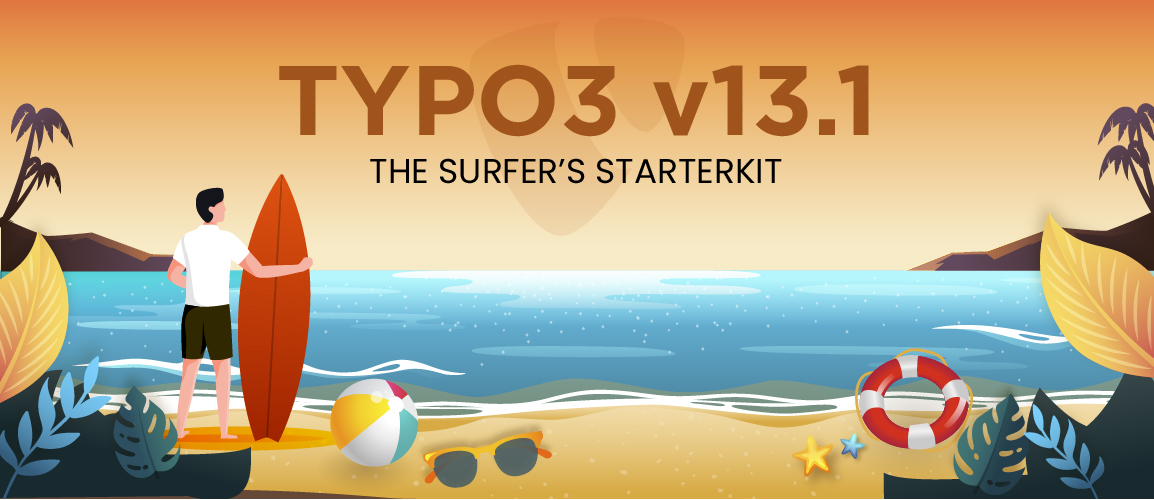Are you tired of the tedious process of creating custom content elements in TYPO3? Say goodbye to the complexities of coding and welcome Mask, the innovative solution that simplifies content creation in TYPO3. In this blog post, we'll explore how Mask revolutionizes the way you build and manage custom content elements, making TYPO3 development more efficient and user-friendly.
Getting Started with Mask
After following the simple installation steps, you can begin using Mask right away.
Installation Guide
This comprehensive guide will walk you through the installation and configuration steps to get started with Mask effortlessly.
Preparations:
Before diving into Mask, ensure that you have set up your site package. This is crucial for seamless integration and customization.
Adding Mask as a Dependency:
Adding Mask as a dependency in your site package's ext_emconf.php is crucial to ensure that Mask is loaded before your Theme extension. This sequence enables you to override the generated TCA from Mask in your Overrides folder effectively.
$EM_CONF[$_EXTKEY] = [
'constraints' => [
'depends' => [
'mask' => '8.1' // Add the minimum version here or leave blank for any version.
]
]
];Access the backend module conveniently located below the extension manager module. With just a few clicks, you'll be on your way to creating personalized content elements tailored to your specific needs.
For Composer installations, don't forget to include the requirement in your extension's composer.json file as well. It's worth noting that in TYPO3 v11, the ext_emconf.php file is no longer required when operating in composer mode.
{
"require": {
"mask/mask": "^8.1"
}
}Note: If you add the dependency after Mask has already been installed and activated, it's necessary to rebuild the loading order by reinstalling your extension.
Installation and Configuration Of Mask in TYPO3:
- Download Mask with Composer by running the command composer require mask/mask or install it via the extension manager.
- Activate Mask in the extension manager. (Not needed in TYPO3 v11 composer mode)
- Mask requires fluid_styled_content, so ensure it is included in your static includes in the template module.
- You can install fluid_styled_content in Composer mode with the command: composer require typo3/cms-fluid-styled-content.
- Also, include the Mask static TypoScript.
- Navigate to the Mask module and enter your site package extension key for auto-configuration (your extension must be loaded).
- Start creating your own content elements effortlessly!
Manual Configuration:
If you prefer to customize the folder structure created by the auto-configuration, you can adjust every path in the extension configuration of Mask.
Tip: It's recommended to have the LocalConfiguration.php file (where the extension configuration is stored) in version control for easy sharing and collaboration.
New Content Element Wizard
To create your first content element, simply click on the "Create new content element" button. This action triggers a wizard that will guide you through filling out some mandatory fields.
Label: Provide a descriptive label for this content element, which will be visible to editors when creating the content element.
Key (unique, lowercase): Assign a unique key to your element. This key is crucial for defining the CType (Content Type) and generating the Fluid HTML templates associated with this content element. Ensure the key is unique and in lowercase letters.
How to Create Fields In Mask?
Now you can populate your element with various fields. Refer to the "Fieldtypes" page for detailed information about all available field types. Simply drag and drop your desired field into the drag area in the middle of the screen. Alternatively, you can click on a field, and it will be inserted below the currently active field. Upon insertion, a form will appear on the right side, allowing you to configure the field according to your requirements.
Similar to the element key, you must devise a unique key for your field. Custom fields always start with the prefix "tx_mask_", which cannot be removed. This prefix is crucial to prevent conflicts with existing fields. Additionally, you have the option to choose from existing TYPO3 core fields or Mask fields in the dropdown menu.
Most fields share the following options:
Field Key: This is the unique key for the field, as described earlier. It determines the name of the new column in the database table tt_content.
Label: The label is what editors will see when editing the content element. It can be a localized string.
Description: This provides additional information for editors and appears below the label. It's helpful for guiding editors on how to use the field.
Reset to Default: This option resets all TCA (Table Configuration Array) options to their default values, excluding the label and description.
Table Configuration Array (TCA)
TCA (Table Configuration Array) is important for Mask in TYPO3 development. The TCA defines the structure and behavior of database tables used by TYPO3 to store content elements, including custom content elements created with Mask.
Here's why TCA is important for Mask:
Database Structure:
TCA specifies the structure of the database tables where content elements are stored. When you create custom content elements using Mask, TCA defines how the data for these elements is stored in the database.
Field Configuration:
TCA allows you to configure various properties of fields within content elements, such as their type, label, description, and validation rules. This configuration ensures consistency and integrity of data stored in the database.
Integration with TYPO3 Core:
TCA provides integration with TYPO3 core functionality, allowing Mask-generated content elements to seamlessly interact with other TYPO3 features and extensions.
Customization and Extensibility:
TCA offers extensive customization options, allowing you to tailor the behavior and appearance of content elements according to your specific requirements. This flexibility enables developers to create rich and dynamic user experiences within TYPO3.
Element Meta Data Tab Using Mask
The Element Meta Data tab provides essential details about your content element in TYPO3. Here, you'll find general information like the label and key, which you may have defined during creation. Additionally, you'll encounter the following fields:
Short Title: This field offers a concise title for your element, visible when selecting the element type. If left blank, the standard title is used.
Description: Adding a description aids editors in understanding the purpose of the element. It appears alongside the title and preview image in the creation wizard.
Icon: Quickly add a preview icon for your element by selecting from a range of FontAwesome icons. Choose from various categories or search by keyword. If no icon is specified, a fallback icon is generated using the first letter of your label.
Color: Customize the icon's color to enhance visual distinction.
Conclusion
Mask revolutionizes content creation in TYPO3, offering a user-friendly solution for building custom content elements with ease. With its intuitive interface, flexible customization options, and seamless integration with TYPO3, Mask empowers developers to create dynamic and engaging websites efficiently. Say goodbye to tedious coding and hello to Mask – your ultimate tool for custom content creation in TYPO3.














Comments and Responses